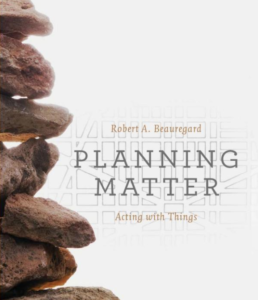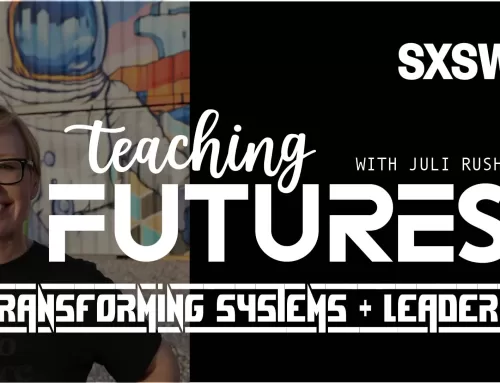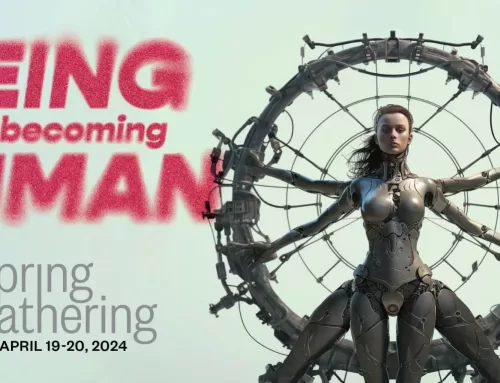 Contributor: Greg Turner
Contributor: Greg Turner
Category: Civilization and History
Title: Planning Matter: Acting With Things
Author: Robert A. Beauregard
Publisher: University of Chicago Press
Publication Date: 2015
Robert A. Beauregard’s premise in Planning Matter is the application of French philosopher Bruno Latour’s “actor-network” theory to urban planning. This notion sees all players in events as equal in meaning, stature, and influence, thus non-humans (inanimate objects, other living creatures, processes, ideas, etc.) are as important as we are. All participate in creating the networks in which and through which relationships and events are created and shaped. Actor-network theory rejects the idea of human “privilege” in the world. Beauregard has very obvious political leanings whose expression generates much of the book’s content, but this review will focus instead on a couple of aspects of the book that I believe might be of interest to those in the field of foresight.
As an example of actor-network theory’s workings, the author describes a hypothetical meeting at a city planning department where approval for a potential project is being discussed. Here not only the human participants’ actions, words, and body language shape events and outcomes, but the inanimate drawings and cardboard models, and relationships between the parties and with outside actors such as banks do as well. Notwithstanding that Beauregard could have selected a more significant illustration—architects have routinely participated in such meetings forever and can testify to the power of presentation materials—the ability of non-living things to shape human conduct is a well-worn path. Winston Churchill famously said, “We shape our buildings, and thereafter they shape us.” Neuroscientist Steven Pinker has noted, “We make tools, and as we evolved our tools made us.” Similarly, despite his emphasis on the importance of non-human actors, Beauregard doesn’t seem to consider them as more than tools. Quite influential ones perhaps, but tools nevertheless. In this sense, he reflects Laura Majors and Julie Shah’s What to Expect When You’re Expecting Robots, who similarly see automatons as powerful instruments, but always a notch below their human creators (see my previous review of this book).
Such myopia highlights a missed opportunity. Beauregard could have shifted the book’s focus and investigated a potentially fascinating outgrowth of Latour’s theory, namely what happens if these “tools” continue to advance and learn. Once past the technologically rudimentary or enhanced levels, to where the machine is truly autonomous or self-aware, it becomes much more than an implement—it is some sort of “being.” In Planning Matter, we are left with a vision of how “things” influence and shape human action, but not how we might all negotiate among ourselves if these things actually possess some level of sentience. Perhaps technology will never reach this level, but it is intriguing to ponder the possibilities.
The author comes tantalizingly close to exploring another aspect of relevance to foresight but is unable to make the leap. While he pines for a centralized planning structure, Beauregard wishes to avoid the shortcomings of a top-down model such as that which characterized the “Modern” period during the twentieth century. He seeks a participatory process that would allow a multi-directional flow of power and action nested within a centralized model, a process that he terms “emergent.” It’s clear, however, that he believes involvement should be limited, and this raises a process issue. In constricting participation, the number of initial conditions of his planning system is likewise limited. Since emergence is an outcome of spontaneous interactions that are dependent on scale (see Richard Feynman, Stuart Kauffman, or Geoffrey West), the likelihood of its occurrence is greatly obstructed when the number and variety of these initial conditions are limited. In other words, outcomes will need to be predetermined because they will not likely occur of their own accord. This is why any centralized structure ends up attracting only those interested in its control. A more intriguing exploration would have been to imagine a system in which the number of actors approaches infinity rather than zero and see what emerges in such a case.
Perhaps my expectations of Professor Beauregard are misguided. After all, he had a different agenda than the one I am seeking to impose on him here. My view, however, is that Planning Matter raises some issues that introduce other even more interesting ones that I wish would be explored—somewhere.
According to Wikipedia, Robert A. Beauregard is and author of many books and professor emeritus at Columbia University where he taught urban planning in the Graduate School of Architecture, Planning, and Preservation.




